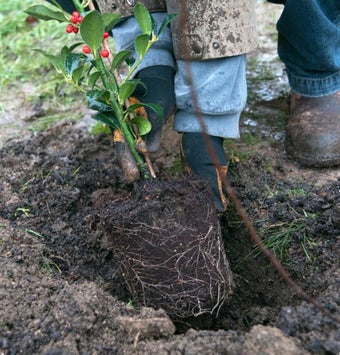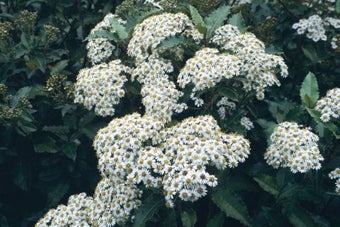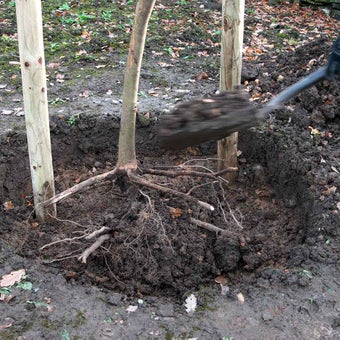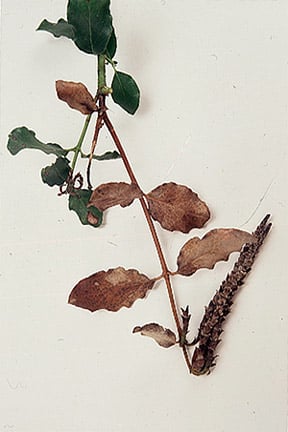
Quick facts
Top plants include: Elaeagnus × ebbingei, hawthorn (Crataegus monogyna), Italian alder (Alnus cordata), sea buckthorn (Hippophae rhamnoides) and small-leafed lime (Tilia cordata)
Suitable for - Any exposed garden
Timing: Plant in autumn, winter or early spring
Difficulty: ModerateTop five plants for a windbreak
Suitable for...
Any exposed garden will benefit from a windbreak in order to:
- Reduce wind speed, preventing damage to evergreen foliage, of shallow-rooted plants, broken fences, shattered greenhouse glass and scattering of containerised plants
- Create shelter, allowing a wider range of plants to be grown
- Provide shelter for pollinating insects, enabling fruit set in orchards
- Reduce moisture loss from soil and plant foliage
- Minimise soil erosion on light soils
- Reduce damage from salt-laden winds in coastal areas
- Provide protection from driving snow
- Screen unsightly views and increase privacy
- Reduce heating costs to greenhouses and dwellings
- Provide a habitat for wildlife, especially if made of mixed species
Note: Windbreaks and shelterbelts have a very limited effect on reducing noise.
Windbreaks: consist of a line of defence such as a hedge, fence, single or double row of trees and can therefore be created in most gardens.
Shelterbelts: are formed of tall trees and shrubs (over 4.5m/14½ft) planted in three or four staggered rows and are therefore only suitable for larger sites.
Choosing the right kind of windbreak
Assess the site carefully to establish the type of windbreak needed and the dimensions and positioning necessary to provide shelter.
Type
To be effective, windbreaks must be semi-permeable, ideally filtering 50-60 percent of the wind to reduce its strength. Solid barriers are unsuitable, leading to damaging eddies of wind on each side.
Windbreaks can be living or artificial. Living windbreaks of planted trees and shrubs are most attractive and long-lasting but artificial screens give immediate protection. Artificial screens can be used alone or in conjunction with living windbreaks to provide shelter while they establish.
Solid fences are unsuitable for slowing wind but any fence with 50-60% porosity, such as woven hurdles of willow or hazel, will be effective. Woven or extruded plastic netting is available to the amateur gardener but, for screens over 1.5m (5ft), professional heavy-duty plastic strapping such as ‘Paraweb’ may be needed.
Dimensions
A windbreak will significantly reduce wind on its leeward side to a distance of ten times its height. Windbreaks should be wider than the area needing protection, or should be extended down the sides, to prevent wind slipping around the sides.
Positioning
In general, windbreaks should face the prevailing winds (which come from the south-west in the UK) but in some situations the priority may be protection from damaging, cold, north and easterly winds.
The lie of the land (topography) affects wind direction and must be taken into account. Hilly sites may need shelter on several sides as wind can come over a hill and also produce gusts round the sides. Wind can also be funnelled along valleys, between lines of trees or tall buildings, creating what is known as a 'wind tunnel'.
How to create windbreaks
Erecting artificial screens
Artificial screens will require fixing to a sturdy supportive structure:
- Posts for screens under 1.5m (5ft) should be 9cm (3½in) in diameter, spaced at twice the screen height. Posts for screens over 1.5m (5ft) should be 10-15cm (4-6in) in diameter, spaced at intervals equal to the height of the screen
- Fit cladding to the windward side of the posts
- Ensure woven or plastic screens are pulled taut
Planting and maintaining living windbreaks
Living windbreaks require site preparation and planting as for hedges and trees. shrubs and trees are best planted from autumn through till early spring; evergreens in spring.
- Buy small, young plants, which usually establish well
- Plant shrubs and trees fairly close together: 30-90cm (1-3ft) between most plants within the row is suitable
- In shelterbelts, large trees should be spaced 2-4 (6½-13ft) apart, with shrubs planted between the lines of trees to slow wind at the base of the belt. In deep shelterbelts, plant the tallest trees at the centre, with shorter trees or shrubs at the front and back
- Put tree guards in place to protect trunks from rabbit damage
- Keep new plantings well mulched, watered and weed-free until they are established
- Rows of trees and hedges can be pruned annually to keep them dense
Plant selection for living windbreaks
Deciduous shrubs and trees
plants, whether as rows of trees or clipped hedges, create permeable barriers suitable for slowing wind speed. Here are some to choose from:
Key
* tolerant of coastal sites
(m) suitable for mild areas, minimum 5°C
Trees:
Acer campestre (field maple)
A. negundo (box elder)
A. platanoides (Norway maple)
A. saccharinum (silver maple)
A. pseudoplatanus* (sycamore)
Alnus cordata AGM* (Italian alder)
A. glutinosa* (common alder)
Carpinus betulus AGM* (hornbeam)
Fraxinus excelsior (ash)
Ligustrum vulgare (m) (wild privet)
Liquidamber styraciflua (sweet gum)
Populus alba 'Pyramidalis' (white poplar)
P. ‘Balsam Spire’ (poplar)
Salix alba* (white willow)
Sorbus aria (whitebeam)
S. aucuparia* (mountain ash)
Tilia americana (American lime)
T. cordata (small-leaved lime)
Ulmus pumila (Siberian elm)
Large shrubs:
Amelanchier canadensis (serviceberry)
Cornus mas (Cornelian cherry)
Corylus avellana (hazel)
Crataegus laevigata* (midlands hawthorn)
C. monogyna* (hawthorn)
Elaeagnus angustifolia (oleaster)
Hippophae rhamnoides* (sea buckthorn)
Prunus spinosa* (blackthorn)
Sambucus nigra* (elder)
S. racemosa (American red-veined elder)
Syringa vulgaris (lilac)
Medium-sized shrubs:
Berberis
Rosa rubiginosa* (eglantine rose)
R. rugosa* (hedgerow rose)
R. pimpinellifolia* (Scotch rose)
Tamarix* (tamarisk)
Evergreen trees and shrubs
Evergreen hedges can offer good year-round shelter in a garden. However, bear in mind that a dense line of evergreens may act like a solid barrier, causing problems with wind turbulence. In a shelterbelt, alternate rows between evergreens and deciduous plants. Here are some evergreens to consider:
Large trees:
Calocedrus decurrens AGM (incense cedar)
Juniperus scopulorum (Rocky Mountain juniper)
Picea abies (Norway spruce)
Pinus contorta var. contorta* (shore pine)
P. nigra* (European black pine)
P. radiata* (Monterey pine)
P. sylvestris (Scots pine)
Pseudotsuga menziesii (Douglas fir)
Quercus ilex* (holm oak)
Thuja plicata (western red cedar)
Tsuga canadensis (eastern hemlock)
Shrubs:
Bupleurum fruticosum* (shrubby hare's ear)
Chusquea culeou AGM (m) (Chilean bamboo)
Elaeagnus × ebbingeiAGM* (Ebbinge's silverberry)
Juniperus communis (juniper)
Phyllostachys flexuosa (m) (sinuate bamboo)
P. nigra f. henonis AGM (m) (Henon bamboo)
P. viridiglaucescens (m) (green-glaucous bamboo)
Pinus mugo* (dwarf pine)
Pittosporum tobira AGM (m) (Japanese pittosporum)
Pleioblastus hindsii (m) (Hinds' -bamboo)
P. simonii (m) (Simon bamboo)
Pseudosasa japonica AGM (m) (arrow bamboo)
Pyracantha* (firethorn)
Rhamnus alaternus* (Italian buckthorn)
Sasa palmata* (broad-leaved bamboo)
Semiarundinaria fastuosa* (Narihira bamboo)
Taxus baccata AGM (yew)
Ulex europaeus* (gorse)






